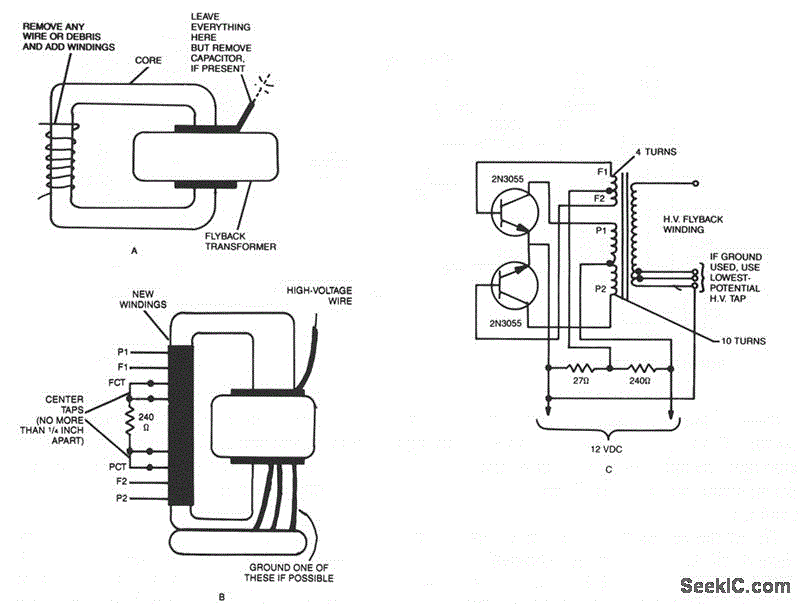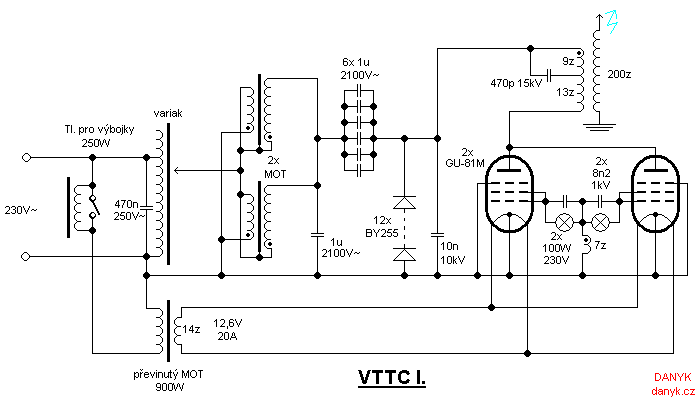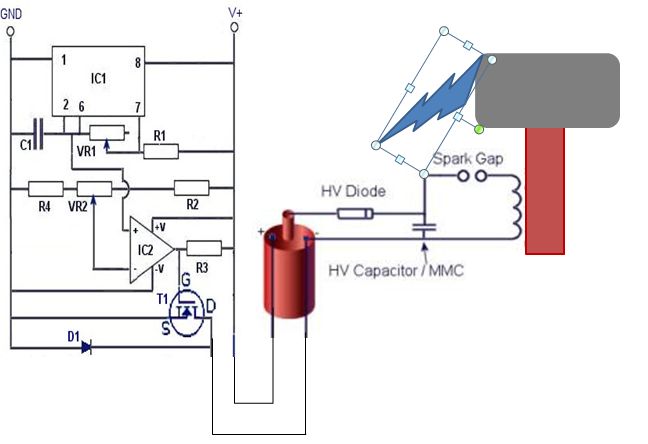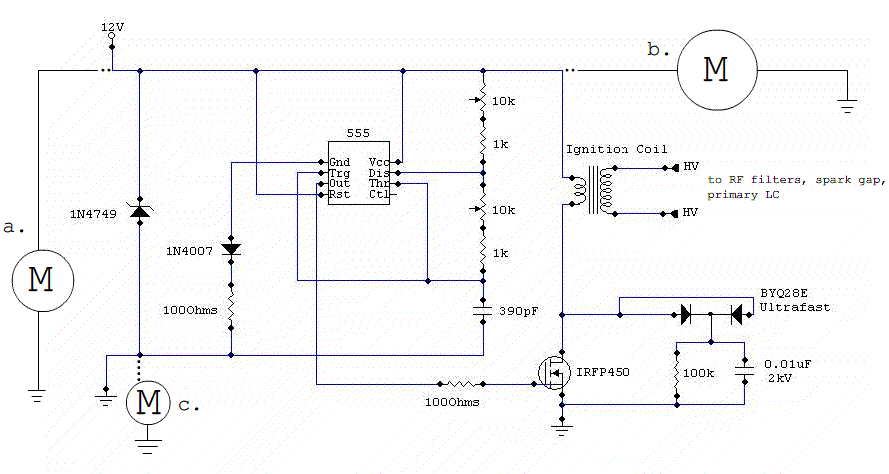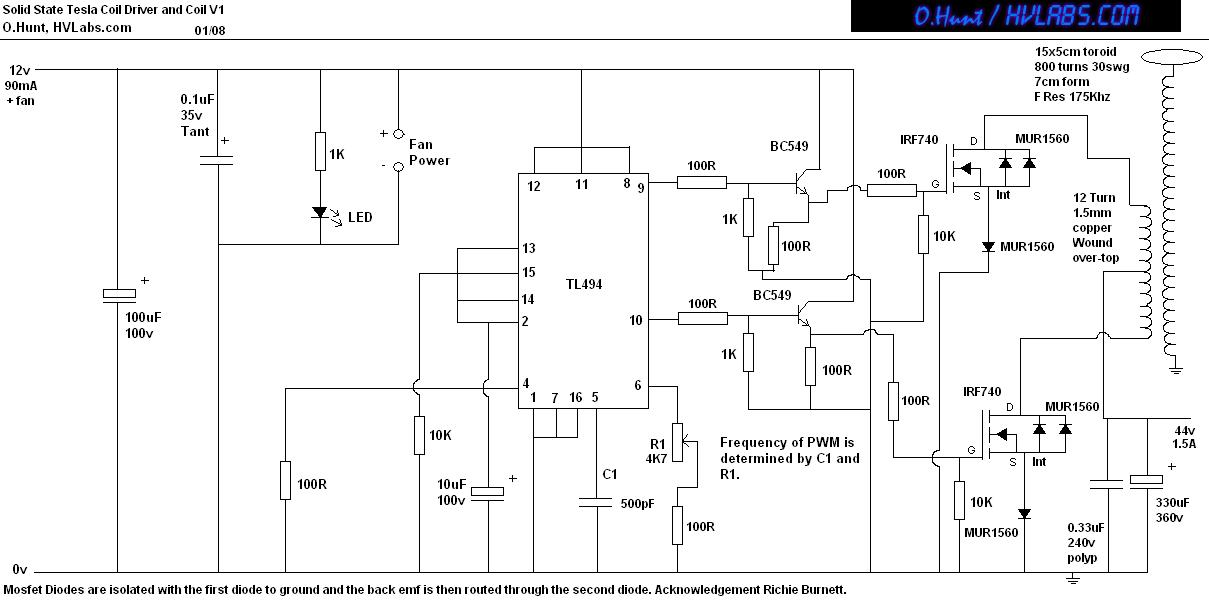
tesla

A low-voltage demonstration Tesla coil utilizing a solid-state photovoltaic relay has been analyzed and constructed to replace the conventional spark gap. This relay features an isolated LED that illuminates a silicon photovoltaic stack, which then drives a bidirectional FET. The component values for the inductances and capacitances have been theoretically determined from measured parameters. Computer simulations integrating the coupled circuit equations reveal excellent agreement with oscilloscope traces. The energy transfer between the primary and secondary circuits is demonstrated, along with continuous secondary oscillations after the primary circuit is interrupted. This low-voltage design offers advantages in terms of construction and diagnostics compared to high-voltage Tesla coils. Nikola Tesla invented the Tesla coil in the late nineteenth century, exploring various high-power configurations in his Colorado Springs laboratory. These were primarily air-cored high-frequency transformers capable of generating extremely high voltages. Tesla's experiments often involved large coils made from heavy copper wires to handle high currents, and his high-voltage capacitors utilized numerous saltwater-filled Leyden jars sourced from a local mineral water bottling plant. Tesla documented his findings with multiple-exposure photographs showing his wooden building filled with sparks extending up to 40 meters. He frequently used spark length as a diagnostic tool for his experiments. Tesla aimed to generate sufficiently high voltages to transmit electrical power wirelessly through the atmosphere. One contemporary account suggested he successfully powered light bulbs located 40 kilometers away. However, he never completed his final and most ambitious experiment on Long Island, New York, which was designed within a 60-meter-high wooden tower. Although funding issues led to the tower's demolition, modern understanding suggests that the experiment would not have succeeded as Tesla envisioned. Despite Tesla's advanced ideas, he lacked the electronic diagnostic tools necessary to analyze his experiments comprehensively. Although his grand plans may not have been feasible, high-voltage Tesla coils continue to captivate interest. The generation of fiery arcs and the ability to light fluorescent tubes from a distance remain thrilling demonstrations. Over the past six decades, instructions for constructing high-voltage Tesla coils have appeared sporadically in popular magazines, journals, newsletters, and books. Hand-held Tesla coils have become valuable instruments in many physics laboratories, capable of exciting gas discharges and detecting leaks in vacuum systems. There is also interest in using large Tesla coils to simulate lightning for military aircraft testing and smaller coils for generating electron beams. While these Tesla coils can serve as experimental subjects, detailed measurements for theoretical comparisons require sophisticated equipment to handle high voltages. A conventional Tesla coil consists of tuned primary and secondary circuits, with an interrupter in the primary circuit that stimulates oscillations from the charge stored in a large capacitor. The design of the primary circuit interrupter is crucial for maximizing power transfer to the secondary circuit. High-power Tesla coils typically employ variations of rotating spark gaps to extinguish high-voltage sparks, a technique unchanged since Tesla's time. This paper proposes replacing that traditional element with modern integrated circuit technology. A BOSFET (Bidirectional Output Switch Field Effect Transistor), while not capable of handling high power levels, possesses the necessary characteristics to make a demonstration Tesla coil practical. The BOSFET comprises MOSFETs combined with an optically coupled LED driver in a compact integrated circuit package, manufactured as a photovoltaic relay. It operates quickly, exhibiting a low ON-resistance.
The low-voltage demonstration Tesla coil presents a significant advancement in Tesla coil technology by integrating modern solid-state components that enhance performance and safety. The use of a photovoltaic relay to replace the traditional spark gap not only simplifies the construction process but also improves reliability and efficiency. The isolated LED provides a clear visual indication of operation, while the silicon photovoltaic stack ensures effective energy conversion to drive the bidirectional FET. The careful selection of inductance and capacitance values based on theoretical calculations allows for optimized performance, ensuring that the energy transfer between the primary and secondary circuits is maximized.
In practical applications, the low-voltage Tesla coil can serve as an educational tool, demonstrating principles of electromagnetism and resonance without the inherent dangers of high-voltage systems. The continuous oscillations in the secondary circuit after the primary circuit interruption showcase the energy retention capabilities of the system, allowing for prolonged demonstrations. Furthermore, the compact and lightweight design facilitates portability, making it suitable for experimental setups in various educational environments.
Future developments may focus on refining the design for improved efficiency and exploring additional applications, such as wireless power transmission experiments or advanced demonstrations in physics education. The integration of modern diagnostic tools could also enhance the understanding of the underlying principles, allowing for more precise measurements and comparisons to theoretical models. Overall, this innovative approach to Tesla coil design represents a blend of historical ingenuity and contemporary engineering, fostering continued interest in the fascinating world of high-frequency electromagnetic phenomena.A low-voltage demonstration Tesla coil using a solid-state photovoltaic relay to replace the conventional spark gap has been analyzed and then built. This relay incorporates an isolated LED to illuminate a silicon photovoltaic stack which drives a bidirectional FET.
Component values for the inductances and capacitances have been determined theoret ically from measured parameters. Computer simulation by integrating the coupled circuit equations shows excellent agreement with oscilloscope traces. Energy transfer between the primary and secondary circuits is demonstrated, along with continuous secondary oscillations after the primary circuit is interrupted.
This low-voltage design is easier to build and diagnose than high-voltage Tesla coils. Nikola Tesla invented the Tesla coil late in the nineteenth century, exploring many high-power variations in his Colorado Springs laboratory (1). They were all basically air-cored high-frequency transformers, generating very high voltages. Many of his experiments were complicated, using large coils made with heavy copper wires to conduct very high currents.
His high-voltage capacitors used hundreds of salt water-filled Leyden jars made from the local Manitou Springs mineral water bottling plant. Tesla documented his achievements with multiple-exposure photographs which show his small wooden building filled with curved sparks up to 40 m in length.
Using spark length is how Tesla often diagnosed his experiments. Tesla`s ultimate goal was to generate high enough voltages that he could transmit useful electrical power freely through the atmosphere. One contemporary account claimed he succeeded in sending enough power to energize a bank of light bulbs 40 km away (2).
However, he never completed his final and largest experiment on Long Island, New York, which he designed inside a 60-m-high wooden tower. Although lack of funding was the primary reason the tower was torn down, in the light of today`s knowledge, it never would have succeeded in the manner he envisioned.
While Tesla was advanced for his time, he didn`t have electronic diagnostic tools to study his experiments. Even though Tesla`s grandiose plans would not have worked, we remain fascinated with high-voltage Tesla coils.
Generating fiery arcs and lighting fluorescent tubes at a distance are always exciting demonstrations. In the last 60 years, instructions for building high-voltage Tesla coils appeared occasionally in popular magazines, journals, newsletters, and books (3-13).
A useful instrument in many physics laboratories is the hand-held Tesla coil used to excite gas discharges and find leaks in vacuum systems. There has also been some interest in using very large Tesla coils to test military aircraft with simulated lightning, (14) and using smaller coils to generate electron beams (15).
While any of these Tesla coils can be experimental subjects, detailed measurements to compare with theoretical predictions requires sophisticated equipment to deal with high voltages. A conventional Tesla coil consists of tuned primary and secondary circuits. An interrupter in the primary circuit stimulates oscillations from the charge stored in a large capacitor.
The primary circuit interrupter design is critical to maximize power transfer to the secondary circuit. High-power Tesla coils use variations on rotating spark gaps to extinguish the high-voltage spark, (16), a technique that hasn`t changed since Tesla used it!
This paper replaces that "ancient" element with modern integrated circuit technology. A BOSFET (Bidirectional Output Switch Field Effect Transistor), while not capable of high powers, has the necessary properties which make a demonstration Tesla coil practical. MOSFETs make up the BOSFET, which are combined with an optically coupled LED driver in a small integrated circuit package, manufactured as a photovoltaic relay.
(17) It turns on and off quickly, exhibits a low ON- 🔗 External reference
The low-voltage demonstration Tesla coil presents a significant advancement in Tesla coil technology by integrating modern solid-state components that enhance performance and safety. The use of a photovoltaic relay to replace the traditional spark gap not only simplifies the construction process but also improves reliability and efficiency. The isolated LED provides a clear visual indication of operation, while the silicon photovoltaic stack ensures effective energy conversion to drive the bidirectional FET. The careful selection of inductance and capacitance values based on theoretical calculations allows for optimized performance, ensuring that the energy transfer between the primary and secondary circuits is maximized.
In practical applications, the low-voltage Tesla coil can serve as an educational tool, demonstrating principles of electromagnetism and resonance without the inherent dangers of high-voltage systems. The continuous oscillations in the secondary circuit after the primary circuit interruption showcase the energy retention capabilities of the system, allowing for prolonged demonstrations. Furthermore, the compact and lightweight design facilitates portability, making it suitable for experimental setups in various educational environments.
Future developments may focus on refining the design for improved efficiency and exploring additional applications, such as wireless power transmission experiments or advanced demonstrations in physics education. The integration of modern diagnostic tools could also enhance the understanding of the underlying principles, allowing for more precise measurements and comparisons to theoretical models. Overall, this innovative approach to Tesla coil design represents a blend of historical ingenuity and contemporary engineering, fostering continued interest in the fascinating world of high-frequency electromagnetic phenomena.A low-voltage demonstration Tesla coil using a solid-state photovoltaic relay to replace the conventional spark gap has been analyzed and then built. This relay incorporates an isolated LED to illuminate a silicon photovoltaic stack which drives a bidirectional FET.
Component values for the inductances and capacitances have been determined theoret ically from measured parameters. Computer simulation by integrating the coupled circuit equations shows excellent agreement with oscilloscope traces. Energy transfer between the primary and secondary circuits is demonstrated, along with continuous secondary oscillations after the primary circuit is interrupted.
This low-voltage design is easier to build and diagnose than high-voltage Tesla coils. Nikola Tesla invented the Tesla coil late in the nineteenth century, exploring many high-power variations in his Colorado Springs laboratory (1). They were all basically air-cored high-frequency transformers, generating very high voltages. Many of his experiments were complicated, using large coils made with heavy copper wires to conduct very high currents.
His high-voltage capacitors used hundreds of salt water-filled Leyden jars made from the local Manitou Springs mineral water bottling plant. Tesla documented his achievements with multiple-exposure photographs which show his small wooden building filled with curved sparks up to 40 m in length.
Using spark length is how Tesla often diagnosed his experiments. Tesla`s ultimate goal was to generate high enough voltages that he could transmit useful electrical power freely through the atmosphere. One contemporary account claimed he succeeded in sending enough power to energize a bank of light bulbs 40 km away (2).
However, he never completed his final and largest experiment on Long Island, New York, which he designed inside a 60-m-high wooden tower. Although lack of funding was the primary reason the tower was torn down, in the light of today`s knowledge, it never would have succeeded in the manner he envisioned.
While Tesla was advanced for his time, he didn`t have electronic diagnostic tools to study his experiments. Even though Tesla`s grandiose plans would not have worked, we remain fascinated with high-voltage Tesla coils.
Generating fiery arcs and lighting fluorescent tubes at a distance are always exciting demonstrations. In the last 60 years, instructions for building high-voltage Tesla coils appeared occasionally in popular magazines, journals, newsletters, and books (3-13).
A useful instrument in many physics laboratories is the hand-held Tesla coil used to excite gas discharges and find leaks in vacuum systems. There has also been some interest in using very large Tesla coils to test military aircraft with simulated lightning, (14) and using smaller coils to generate electron beams (15).
While any of these Tesla coils can be experimental subjects, detailed measurements to compare with theoretical predictions requires sophisticated equipment to deal with high voltages. A conventional Tesla coil consists of tuned primary and secondary circuits. An interrupter in the primary circuit stimulates oscillations from the charge stored in a large capacitor.
The primary circuit interrupter design is critical to maximize power transfer to the secondary circuit. High-power Tesla coils use variations on rotating spark gaps to extinguish the high-voltage spark, (16), a technique that hasn`t changed since Tesla used it!
This paper replaces that "ancient" element with modern integrated circuit technology. A BOSFET (Bidirectional Output Switch Field Effect Transistor), while not capable of high powers, has the necessary properties which make a demonstration Tesla coil practical. MOSFETs make up the BOSFET, which are combined with an optically coupled LED driver in a small integrated circuit package, manufactured as a photovoltaic relay.
(17) It turns on and off quickly, exhibits a low ON- 🔗 External reference
